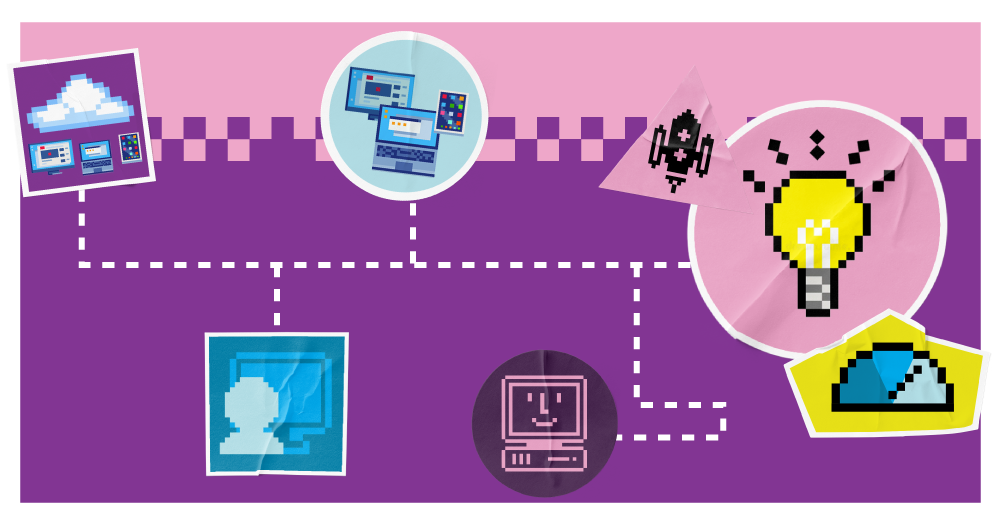A target operating model (TOM) is as a blueprint for how IT teams can deliver value, drive operational efficiency and support business growth. It clearly defines the processes, technology, people and governance structures required to achieve organisational objectives. This transforms IT from a functional necessity into a true strategic partner.
And achieving TOM excellence has never been more important. As digital transformation accelerates, many organisations face mounting pressures. IT is too often deprioritised, teams struggle with widening skills gaps, budgets tighten as expectations rise and leaders feel overwhelmed by the relentless pace of technology change. These challenges can stall progress and dilute IT’s impact on business outcomes.
But there is another way. Leveraged correctly, IT can become a strategic value driver for your business, fuelling growth and efficiency. In this blog, you’ll find practical, actionable insights that empower IT leaders and their teams to build a robust TOM that streamlines processes and delivers measurable value to the business.
Why IT deserves a seat at the strategy table_
In the digital age, effective IT is mission-critical to growth and innovation. But it’s too often left at the periphery when strategic decisions are made. Many organisations still view IT as a cost centre or a troubleshooting, despite relying on technology for virtually every aspect of operations and customer experience. Research we conducted found that over half of businesses feel like their IT is reactive, rather than proactive.
When IT is sidelined in strategic planning, there can be significant negative consequences. Without a voice at the table, technology decisions are made in silos, disconnected from core business objectives. This often leads to fragmented systems, duplicated investments and missed chances to harness emerging tools that could reshape operations or open new markets. It also opens your business up to increased technical debt and security vulnerabilities.
This is precisely where a well-defined IT target operating model becomes indispensable. By establishing a TOM, you create the essential framework that moves IT from the periphery of decision-making into the heart of strategic collaboration. The TOM provides clarity on roles, responsibilities and processes, ensuring IT’s involvement in business-critical decisions from the outset. It bridges the gap between vision and execution, making sure every technology initiative is purposeful, scalable and resilient.
Defining your ideal IT operating model_
Creating an effective IT TOM requires a holistic approach that balances structure with adaptability and aligns every aspect of IT with the broader objectives of the organisation.
At its core, the TOM defines how IT delivers value, supports business strategy and evolves with changing demands. Key components include:
People: skills, role and culture_
The foundation of any TOM lies in its people. Ensuring your teams have the right skills, clear responsibilities and a shared culture of innovation and accountability is crucial. This means investing in ongoing professional development, fostering collaboration across departments and encouraging a growth mindset that embraces change and new technologies.
Well-defined roles prevent duplication of effort and help IT teams focus on high-value activities that drive strategic outcomes.
Processes: workflow efficiency, automation and governance_
Streamlined and standardised processes are essential for consistent service delivery and operational excellence. Automation plays a pivotal role in reducing manual workloads, minimising errors and freeing up time for strategic initiatives.
Strong governance structures ensure compliance, manage risk and provide the necessary oversight to keep IT initiatives aligned with organisational priorities. Documented workflows and continuous improvement cycles further enhance efficiency and resilience.
Technology: infrastructure, platforms and emerging tools_
The technology landscape is in constant flux. A future-ready TOM leverages modern infrastructure and scalable platforms that support innovation and growth. Embracing the right emerging tools, from AI-driven analytics to advanced cyber security solutions, ensures IT is equipped to meet the demands of a fast-changing business environment while maintaining a secure and reliable foundation.
Data: integration, accessibility and decision-making_
Data is the lifeblood of digital transformation. Integrating data across systems provides a unified view of operations, enabling timely and informed decision-making. A mature TOM ensures data is accessible to those who need it, governed by robust privacy and security frameworks and used strategically to identify opportunities, measure performance and anticipate future needs.
Aligning TOM with business goals and customer outcomes_
The ultimate litmus test for any TOM is its alignment with business strategy and customer value. This means IT must work with business leaders, ensuring every investment and initiative is mapped directly to business goals and customer expectations.
When the TOM is truly integrated, IT becomes a proactive partner, anticipating needs, driving innovation and delivering outcomes that matter.
Diagnosing the gaps: what’s holding your IT back?
Despite the promise of transformation, many IT teams encounter persistent roadblocks that hinder progress.
In the last few years, the ongoing skills shortage has been a significant barrier. With a lack of IT skills impacting several industries, many businesses do not have the resource they need for their IT needs. In a fiercely competitive market, attracting and keeping the right specialists is also an ongoing struggle that can stall innovation and limit agility. But without the resource required, it becomes impossible to operate optimal IT functions – much less refine and grow them to be value drivers.
On top of this, businesses face budgetary constraints and the continued reliance on legacy systems. Financial limitations force tough choices, often favouring the maintenance of outdated infrastructure over strategic investment in new solutions. These legacy systems, while familiar, can become bottlenecks, hampering flexibility and inflating operational risk. This drives down ROI and efficiency, leading to IT becoming a cost machine.
Another common barrier is organisations’ abilities to keep pace with rapidly emerging technologies. The speed at which innovations such as AI, cloud computing and automation are developing means IT must constantly scan the horizon, upskill teams and reframe strategies. These tasks are difficult when resources are stretched thin. It also prevents business gaining value from their IT and utilising it to fuel growth and competitive advantage.
Finally, siloed operations and weak cross-functional collaboration slow the journey toward a truly integrated TOM. When teams operate in isolation, opportunities for synergy are lost and efforts are duplicated, ultimately impeding the delivery of unified, business-aligned outcomes. This is another reason in the argument for IT being a core, strategic heart of your business, rather than sidelined.
Building a smarter, leaner, more agile IT function_
To break through these barriers, organisations must rethink their approach to IT capability and culture. Creating a smarter, leaner and more agile IT function focuses on putting your efforts where they count most. Here are four strategies that help drive this transformation:
- Upskilling and reskilling initiatives: Modern IT demands are constantly evolving and so must your talent. Prioritising ongoing upskilling and reskilling ensures teams remain adept at new technologies and methodologies. This can involve formal certifications, on-the-job training, mentorship programs and collaborative learning environments, all designed to build a workforce that’s flexible, forward-thinking and capable of tackling tomorrow’s challenges as they arrive.
- Prioritising investments with ROI-focused planning: Every pound spent on IT should deliver measurable value. ROI-focused planning means rigorously analysing potential investments, aligning them with business priorities, and ensuring that each initiative demonstrably supports growth, efficiency, or customer experience. By systematically tracking and optimising returns, IT leaders can shift the narrative from cost centre to value generator, building a compelling case for continued innovation.
- Leveraging cloud, automation and low-code/no-code platforms: Adopting cloud solutions and automation tools allows organisations to scale rapidly, reduce maintenance burdens and boost responsiveness. Meanwhile, low-code and no-code platforms empower business users and IT professionals alike to develop, iterate and deploy solutions without deep coding expertise. This democratises innovation, shortens development cycles and helps IT keep pace with the business’s evolving needs.
- Creating cross-functional teams and agile workflows: Breaking down silos and encouraging agile, cross-functional teams is foundational to IT transformation. By fostering collaboration between IT and business units, organisations ensure that solutions are designed with the end user in mind, priorities are aligned and bottlenecks are swiftly overcome. Agile methodologies, with their iterative cycles and emphasis on feedback, help teams adapt quickly, delivering value faster and more reliably.
Measuring success: KPIs and continuous improvement_
To ensure transformation becomes operational reality, organisations must anchor their progress in clear metrics. Measuring the effectiveness of your TOM requires a blend of quantitative and qualitative insights, creating a data-driven culture of continuous improvement.
Key metrics to track TOM effectiveness include:
- Process efficiency: Monitor how well workflows and systems are optimised by tracking throughput, error rates and resource utilisation. Improvements here indicate reduced waste and a tighter alignment of IT with business operations.
- Time-to-value: Gauge how quickly new initiatives, features or solutions deliver business benefits. Shortening this metric reflects greater agility and responsiveness to market demands.
- Innovation velocity: Track the frequency and impact of new ideas brought to market, such as number of automation initiatives launched, cloud migrations completed or digital products delivered. High innovation velocity signals an IT function that’s acting as a true enabler of business growth.
- User satisfaction: Use direct feedback from internal and external stakeholders, including surveys and net promoter scores, to assess how well technology is supporting everyday workflows and customer experiences.
Equally crucial is embedding robust feedback loops and iterative refinement into your operating rhythm. Organisations should regularly revisit these metrics, using feedback from users, performance data and retrospective reviews to inform ongoing adjustments. This commitment to continuous improvement helps IT functions gain momentum while constantly aligning with business goals, adapting to technological shifts and capitalising on opportunities for innovation.
How managed services enable TOM success_
In the evolving landscape of technology operating models, managed service providers (MSPs) play a pivotal role in accelerating transformation and ensuring sustainable, long-term success. By partnering with an MSP, organisations can seamlessly evolve their TOM while maintaining operational excellence and strategic focus.
An MSP can bring advantages like:
- Expertise on demand: The pace of technological innovation often outstrips the ability of internal teams to keep up. Managed services provide instant access to specialised skills, from cloud migration experts to cyber security analysts. This on-demand expertise bridges critical skills gaps, empowers internal teams and injects fresh, up-to-date knowledge into transformative projects.
- Scalable solutions for growth: TOM transformation isn’t static; it requires a framework that flexes as the business expands or pivots. MSPs deliver scalable services that can increase capacity, support new business units or introduce emerging technologies without significant upfront investment. Whether scaling up to support rapid growth or scaling down to optimise costs, managed services ensure agility without compromising stability.
- Process optimisation and best practices: Leveraging automation, continuous monitoring and industry best practices, MSPs help organisations streamline core IT processes. From self-healing infrastructure to automated compliance checks, they deliver operational efficiency, reduce manual effort and minimise errors. This relentless optimisation unlocks productivity and frees up internal resources to focus on innovation.
- Strategic alignment with business outcomes: The most effective MSPs act as true strategic partners, aligning IT delivery with overarching business objectives. Through regular service reviews, data-driven insights and proactive road mapping, they ensure every IT initiative directly supports business goals – whether that’s improving customer experience, accelerating digital product launches or enhancing operational resilience.
Reframing IT: from cost centre to value creator_
As organisations embrace new operating models and leverage managed services to accelerate transformation, it becomes essential to move beyond the traditional view of IT as a cost centre. Instead, IT should be recognised as a powerful driver of value creation: fuelling innovation, enabling business agility and directly contributing to strategic outcomes.
By tracking innovation velocity, embedding continuous improvement, and forming strategic MSP partnerships, IT teams are empowered to deliver measurable impact across the enterprise.
To support this transformation, a robust approach to service design is invaluable. Our service design eBook explores methodologies and frameworks that help IT leaders reimagine the user experience, align technology delivery with business aspirations and turn every service interaction into an opportunity for value creation. By adopting these principles, organisations can ensure that IT is not simply supporting the business but actively shaping its future.





